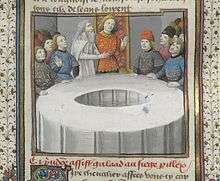Siege Perilous

In Arthurian legend, the Siege Perilous (also known as The Perilous Seat) is a vacant seat at the Round Table reserved by Merlin for the knight who would one day be successful in the quest for the Holy Grail.[1] The English word "siege" originally meant "seat or throne," coming from the Old French sege (modern French siège); the modern military sense of a prolonged assault comes from the conception of an army "sitting down" before a fortress.[2]
In Thomas Malory's Le Morte d'Arthur, in an account taken from the Vulgate Queste del Saint Graal,[3] the newly knighted Sir Galahad takes the seat in Camelot on Whitsunday, 454 years after the death of Jesus. The Siege Perilous is so strictly reserved that it is fatal to anyone else who sits in it. Another version of this story is related in Alfred Tennyson's Idylls of the King.[4]
Originally, this motif about the seat and the grail belonged to Perceval, but the Lancelot-Grail Cycle transferred it to the new Cistercian-based hero Galahad. It appears, for example, in the earlier De Boron Didot Perceval, where Perceval occupies the seat at Arthur's court at Carduel.[5] According to many scholars, the motif of the dangerous seat can be further traced to Welsh, Cornish, and Breton mythology, where the bulk of the Arthurian legend was derived from. According to this theory, the Siege Perilous was a half-remembered version of a Celtic kingship ritual that has parallels in the Irish Lia Fáil.[6]
References
- ↑ Malory T., Morte Darthur, The Globe Edition, Macmillan and Co., London 1868, Book XI, p.326: "he shall be born that shall sit there in that siege perilous, and he shall win the Sangreal." Facsimile by Google Books
- ↑ Harper, Douglas. "siege (n.)". Online Etymology Dictionary. Retrieved 1 July 2018.
- ↑ Norris, Ralph C. Malory's Library: The Sources of the Morte Darthur (D.S. Brewer, 2008), p. 114.
- ↑ Tennyson, A., Idylls of the King, 1856: "And Merlin called it 'The Siege perilous'"(forgottenbooks.org 2007 edition at Google Books)
- ↑ http://www.maryjones.us/ctexts/pd01.html
- ↑ R. S. Loomis. Celtic Myth and Arthurian Romance (Academy Chicago Publishers; revised ed. 1997).